The Prehistoric Times
Paleolithic Age ( Old Stone Age ) ( 2 Million – 8000 BC )
Paleolithic Age, also known to be the old stone age, begins somewhere between 2 million years ago and ends 10.000 years before our time. This time period marks the beginning of the existence of the ancestors of man.
The early man in the Paleolithic age did not know to farm and raise crops but lived on picking up vegetables, fruit and on hunting. In search of the new food sources and to be able to hunt animals, he moved from place to place , and gathered in small groups. His dwelling was in rocky areas, under big rocks and in caves. In areas where this condition could not be met he made easy and primitive shelters out of wood. Around 40.000 BC he started making simple stone tools for hunting and protection purposes.

Between 40.000 and 10.000 is the glacial age on earth. Not being able to move much due to the climate, the primitive man utilized the skin of the animals that he hunted by successfully carved stones. To make clothes he used pins made out of bones and saw animal skin covers for himself. During this hard time of survival , he was able to discover and to control fire and by doing so he happened to have passed an important step in his development which helped him be separated from the animals. In this same period the earliest notion of the need to believe in an other world or in a mightier power can also be traced. In the graves that were dug for the dead as simple holes he left food by the side of the deceased and this is interpreted to be his faith in afterlife. To sum up, the hard conditions of life in the glacial age led the early man develop better socially and technically. The passage from the very primitive man, namely Home Neanderthal, to the ancestor of the modern man, namely Home Sapiens who is dated to between 10.000 and 8.000 may also be considered in this period.
In the last phases of the Paleolithic age the early man could make tools in order to make different new tools. The first works of art emerged in this era too: paintings made on cave the walls and various art objects such as low reliefs and figurines.The intellectual life of the man was beginning. Moreover, animal bones, teeth and shells the ornate objects demonstrate the first aesthetic concern in man.
The fact that in Paleolithic Age, the Asia Minor is extremely rich in fossils and fragments of human beings and animals, of stone, of bone and of vegetation, as well as of works of art reveals that Anatolian land was intensely inhabited during this period. The most important place in Anatolia where all the three phases; Upper, Middle and Lower in the Paleolithic Age can be seen, is the Karain Cave on the 30 km northwest of Antalya. In this respectively big cave, there are various living sections from each of the three phases of the Paleolithic Age. Among the finds are many carved stone and bone tools, moveable art objects, remains of the bones and teeth of Homo Neanderthal and Homo Sapiens, burnt and unburned animal and bread fossils. Karain cave in the Paleolithic Age is not a crucial excavation site only for Anatolia but also for the Near East. One can see some of these remains in the Museums of Karain, in Antalya and in Ankara Museum of Anatolian Civilizations.
